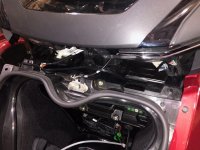Mike0123
Member
As I was pulling an SAE connector wire from the battery to the seat area, I realized there is a lot of room in that spot under the cheesy panel at the base of the windshield, top of the frunk. Does it make sense to run 12 or 10 gauge positive and negative from the battery to that area, and then use a fuse block with a negative bar to hook up the tender, heated gear connectors etc? LED’s??
I could maybe switch the whole fuse block through a relay too.
Make sense?

TIA
I could maybe switch the whole fuse block through a relay too.
Make sense?

TIA
Last edited by a moderator:
